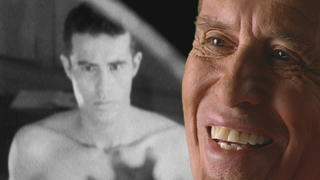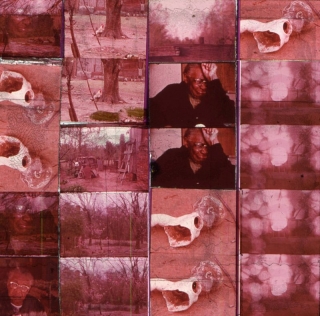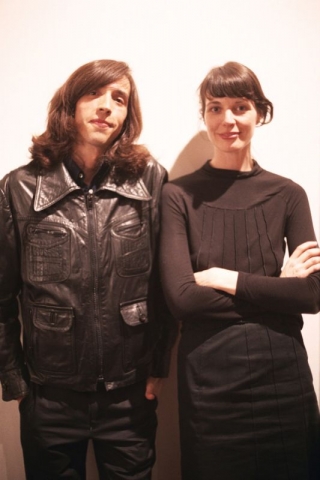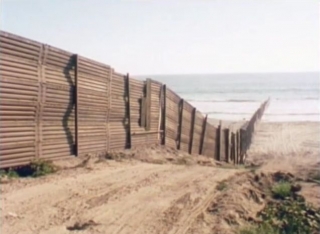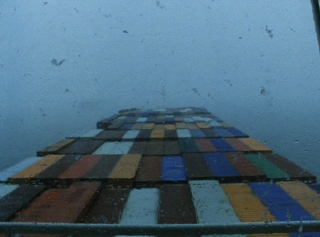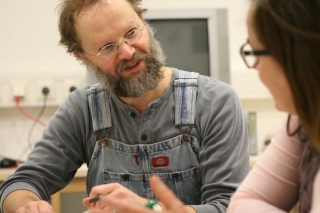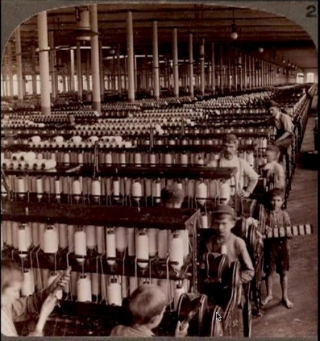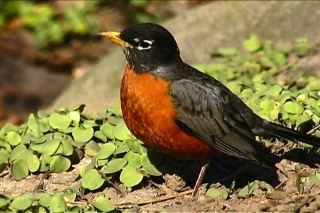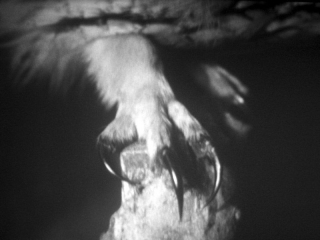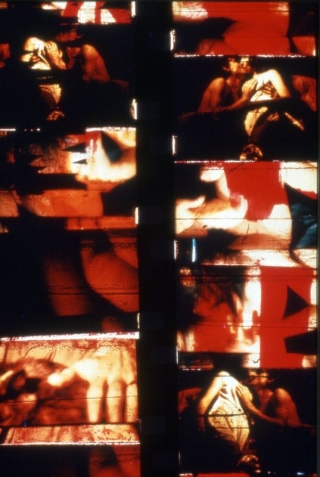Date: 29 October 2006 | Season: London Film Festival 2006 | Tags: London Film Festival
ANGER ME
Sunday 29 October 2006, at 7pm
London National Film Theatre NFT3
Elio Gelmini, Anger Me, Canada, 2006, 72 min
A portrait of Kenneth Anger, legendary pioneer of independent film-making. Raised in Hollywood, a spell as the Changeling Prince in A Midsummer Night’s Dream (1935) provided his first taste of the fantasy world of the movies. The nine films Anger made between 1947 and 1980 are shown together as the ‘Magick Lantern Cycle’, emphasising his belief in cinema as magical weapon. An authority on Aleister Crowley, his dazzling montage invokes myth and ritual, exploring taboo subjects and popular culture with a complex iconography. From the homoerotic fantasy Fireworks to the transcendental Lucifer Rising, his influence reaches beyond the avant-garde and into the mainstream, touching the work of Jarman, Lynch, Scorsese and countless others. Anger’s fascination with film history, memorabilia and scandal eventually led to the bestseller Hollywood Babylon, a dark exposé of Tinseltown’s seamy side. He inadvertently invented the music video with Scorpio Rising, and his acquaintances ranged from Anaïs Nin and Alfred Kinsey to the Rolling Stones. Anger Me takes the form of an extended monologue, in which this visionary artist talks at length about his extraordinary life and remarkable body of work.
Also Screening: Friday 27 October 2006, at 1:45pm, London NFT2
PROGRAMME NOTES
ANGER ME
Sunday 29 October 2006, at 7pm
London National Film Theatre NFT3
ANGER ME
Elio Gelmini, Canada, 2006, video, colour, sound, 72 min
The documentary Anger Me is the story of the life, literary and motion-picture accomplishments of Kenneth Anger, a pivotal figure in the history of experimental film. An innovator and a pioneer, he literally blazed his own trail. Considered to be one of the major personalities of the 1960s and 1970s underground art scene, Kenneth defined himself as a ‘cinematographic magician’ and his cinema as a ritualistic form. Anger’s films have taken audiences places where only great film poets can arrive. In 1947 in Los Angeles, while his parents were away, a young Kenneth took his family’s film camera and shot a short, dramatic film entitled Fireworks, which is now considered one of the seminal works of experimental film. Expressive, imagistic, sexually charged, and made with the help of friends (and apparently without a script), Fireworks brought to the screen an unconstrained vision and an almost unbelievable candor. Kenneth Anger also led in the field of visualization of homoerotic imagery. Fireworks was a film that went beyond maturity and sexual conscience – an extraordinary event considering that it was made in 1947. Kenneth did not cross over to commercial cinema. Throughout his career he has been completely devoted to uncompromising expression. Since the 1960s, Kenneth Anger’s films have been the subject of many books, film panels and film theory courses. Although he has never made a commercial music video, he has even been called the ‘Godfather of MTV’.
Kenneth Anger: The Man, the Filmmaker, and the Author
Many things have been said and written about Kenneth Anger, however, meeting the man only serves to add greater mystery to his reputation. He seems to disdain casual conversation, but when asked a question about his past or his work, he comes alive, as though he is an actor who just heard the word ‘action’. Kenneth Anger seems to have very little interest in his place in history – film history, literary history, homosexual history or otherwise. As Anger himself likes to put it: ‘I just made Kenneth Anger films’. Kenneth Anger is particularly well known for his films Fireworks (1947), Inauguration of the Pleasure Dome (1954), Scorpio Rising (1963) and Lucifer Rising (1970-81). He is less known as an author. In 1959, primarily to make money, Kenneth Anger published the first of a ‘tell-all’ series of books entitled ‘Hollywood Babylon’. His objective was to demonstrate the theory that Hollywood is a relentless machine, always ready to swallow and destroy whomever oversteps allowed boundaries in the search of fame, glory and celebrity.
Anger’s filmmaking style
Anger’s films incorporate the stylistic and expressive techniques of film masters such as Sergei Eisenstein, Abel Gance and D. W. Griffith. Carel Rowe offers the following thoughts on how Kenneth Anger inherited and put into practice the lessons of the great Russian master, Eisenstein: “The importance of Anger’s use of Eisensteinian principle is that it is not reduced to a craft, a trick in time, but maintained as an artistic vision. Art comes from the filmmaker’s reassembling of the splinters of time and space with the inclusion of the intellectual, psychological, or emotional content of the event. The collision of two separate images creates a third distinct impression to the viewer. Similarly, the blending of two dissimilar images into one accumulative essence yields a poetically metaphoric statement on that which is portrayed. This is the artistic importance of Eisenstein’s theory. Its potential is rarely realized in film, and even more rarely as true to theory as in Anger’s films.”
Influences on future generations of filmmakers
Anger’s film Fireworks is considered by many to be the starting point for the only movie ever made by Jean Genet, Un Chant d’Amour (1950). In Paris, Jean Cocteau, who had been much affected by Fireworks in the 1950s, called Mr. Anger and gave him permission to make a movie of his ballet, ‘Le Jeune Homme et la Mort’. Although Kenneth Anger approached many producers with Cocteau’s letter, none of them were interested, as all of Cocteau’s films had lost money. Contemporaries like Stan Brakhage, and Harry Smith were influenced by and expanded upon Kenneth Anger’s approach in what was known as the ‘underground’. Later on, this ‘underground’ influenced Martin Scorsese, the contemporary mainstream exponent of this expressionistic style, who openly acknowledges Kenneth Anger’s influence on his film technique.
Cinema as ‘magick’ and ritualistic form
Kenneth Anger has always defined himself as a ‘cinematographic magician’ and declared that his intention was that of projecting his films directly into the minds of the audience. Anger further credits the use of esoteric symbolism, prevalent in his films, to Aleister Crowley (1875-1947), the great magician, advocate of Gnosticism and neo-paganism. Crowley was a highly controversial, complex and fascinating figure of the 20th Century. Anger also consistently referenced the French poets Charles Baudelaire (1821-67) and Arthur Rimbaud (1854-91), the initiators of European Symbolism.
Aleister Crowley – Céfalù, Italy
Kenneth Anger was greatly influenced by the writings of Aleister Crowley, who lived for three years in Céfalù, in an 18th Century farmhouse, which he called the Abbey of Thelema. It was there that he put into practice the principles of his neo-pagan religion, essentially ‘Do what thou wilt shall be the whole of the Law’. On May 1, 1923, Crowley, already a notorious figure, was expelled from Italy by the order of Mussolini’s police after an accidental death on the site. Anger himself visited Céfalù years later and documented what was left of the paintings and objects.
(Elio Gelmini)
Back to top
Date: 29 October 2006 | Season: London Film Festival 2006 | Tags: London Film Festival
SHINE ON
Sunday 29 October 2006, at 9pm
London National Film Theatre NFT3
Luther Price, Same Day Nice Biscotts, USA, 2005, 6 min
A bleak but touching incantation composed from 13 identical prints of an early 70s documentary on elderly Afro-Americans. Time has taken its toll on the raw material too: now faded and worn, it is steeped in pathos.
Ken Jacobs, Krypton is Doomed, USA, 2005, 34 min
The original Superman radio play from 1940 accompanies the mind-bending ‘Nervous Magic Lantern,’ a filmless projection system that twists light into a perpetually throbbing mass of impossible depth. Presented by the film-maker as a metaphor for the onset of WWII, the apocalyptic narrative could be read as allegory for the present, a world of instability with the potential of environmental collapse.
Courtney Hoskins, The Counter Girl Trilogy, USA, 2006, 6 min
In an inventive response to the cosmetics industry, Hoskins has created imagery from some unusual materials discovered while working as a sales assistant on a make-up counter.
Dietmar Brehm, Blah Blah Blah, Austria, 2006, 13 min
Hotwiring history, the film-maker excavates his image bank of 16mm footage to reveal an archaeology of clandestine pursuits that hovers between ennui and agitation. Brehm’s week beats your year.
Barbara Sternberg, Surfacing, Canada, 2005, 10 min
An exodus of ghostly footsteps pass through the frame beneath layers of scratched emulsion, suggesting the transience of being and a state of emergence beyond the everyday.
Michael Robinson, And We All Shine On, USA, 2006, 7 min
‘An ill wind is transmitting through the lonely night, its signals spreading myth and deception along its murky path. Conjuring a vision of a post-apocalyptic paradise, this unworldly broadcast reveals its hidden demons via layered landscapes and karaoke, singing the dangers of mediated spirituality.’
PROGRAMME NOTES
SHINE ON
Sunday 29 October 2006, at 9pm
London National Film Theatre NFT3
SAME DAY NICE BISCOTTS
Luther Price, USA, 2005, 16mm, colour, sound, 6 min
A mournful dissolving jewel set in bruised magenta sends out votive glints of dying light. A lone bird chirps and branches cover our eyes. Working from a stack of abandoned multiple film prints (nearly identical and close to thirteen in number), Luther Price makes reiterative loops that underline futility, echo hope, and mark every camera movement with the vain promise of fresh outcome and inevitable predestination. (Mark McElhatten)
KRYPTON IS DOOMED
Ken Jacobs, USA, 2005, video, colour, sound, 34 min
In his 5th floor walk-up on the Lower East Side, Jack Smith was determined to complete the beautification of his kitchen cabinet. AIDS was pressing. His friends pitched in, accepting slave status. Jack demanded this and Jack demanded that but because he wanted it perfect (as he had wanted his films to be perfect), and because perfection proved elusive, the remodeling finally had to be abandoned. Each friend going his or her own sad way. We are living under the imminent threat of GODS. The Republican ploy of allying with the religious right for votes is proving shortsighted (grasping individuals tend to be shortsighted) and, as in Iraq, our own religious crazies are now avid for fulfillment. Of prophecy. You’ve got to hand it to those who resist, for the sake of the grass and the animals and the children, and for the preservation of the occasional work of art among the Fabergé eggs, and who knows but that they will succeed against all odds and swerve their respective societies away from sure doom. We like to think so, and it’s easy to, after a lot of movies and the fact that all the living are beneficiaries of the ones who made it through – through normal attrition, that is, all those Papas and especially Mamas that did succeed in sending forward their young. In the late 1930s two Jewish teenagers came up with the story of a couple that sent their infant child on a lone trip of escape through space from an exploding planet. We all know the story: the boy would survive on Earth but would have to keep his identity secret. Were Joe Shuster and Jerry Siegel dreaming out loud? Was Krypton the Old World heading into WWII and was the child escaping the fate of the Jews of Europe? The Jews then, all of us now. Jack’s friends failed to convince him to make a will. ”Why bother?” he asked. ”To protect your work in the future.” ”The future?” Jack replied, “The future will be worse.” (Ken Jacobs)
THE COUNTER GIRL TRILOGY
Courtney Hoskins, USA, 2006, 16mm, colour, silent, 6 min
To make ends meet, I took a job as a makeup counter salesperson. At first, I found this employment to be very satisfying. I was able to smell perfumes all day and ‘paint’ faces with makeup. After all, the human face is a fascinating canvass. The most subtle change can have dramatic effects (for example, it is amazing what a small touch of purple on the eyelids can do for green eyes) ! One day, that bottle of perfume came crashing down on the tile floor. The stench of reality woke me from my drugged state. I was required to go through several training seminars given by the cosmetics corporate giant. Nestled comfortably in the Rocky Mountains, I sat in horror as the ‘rep’ went over our ‘job duties’. My job went from ‘makeup artist’ to ‘scam artist’ right before my eyes! I learned that the average woman in Western society uses twenty cosmetics products each morning. I learned that this ‘average woman’ will also spend money she doesn’t have on cosmetics before spending it on anything else. Most disturbingly, I learned how to manipulate women by playing off of their insecurities. It’s no wonder these companies are so powerful. I couldn’t immediately quit my job, so I tried to make the best of it. One day, I happened upon three amazing shades of lip gloss that were hidden away in a drawer. Although they were for sale, they were not on the display wall. These particular lip glosses contain cholesterol, which in 1888, Fredrich Reinitzer discovered could be manipulated to exist as a new state of matter. He soon coined the word ‘liquid crystal’. I had been trying to purchase liquid crystal materials for my films for some time. I had only managed to find one or two different types. Because the materials are used in computer screens (and, as I learned, lip gloss), they are kept under wraps. I would never have guessed that such incredible materials would have fallen into my lap while working one of the worst jobs I have ever had. (Courtney Hoskins)
BLAH BLAH BLAH
Dietmar Brehm, Austria, 2006, 16mm, colour, sound, 13 min
An essay on restlessness: Blah Blah Blah (based on a song by Iggy Pop: Dietmar Brehm “never really liked it”, but likes it for that very reason) contains a large number of various kinds of shots in a montage which alternates between contemplative scenes and rapid cascades of images. Brehm uses sounds of rain and thunder, with which he is quite familiar, on the soundtrack. In addition a beat measures the rhythm, and its regularity is what makes the Blah Blah Blah project ‘measurable’. Dietmar Brehm has devoted himself to filming his own footage at a higher speed. He uses images typical of a still life (whisky bottles, ashtrays, etc.) and refracts them ironically (a chair stands on two legs), combines them with footage used in earlier works, and arranges them in a row like fragmentary thoughts. The result is a consciousness film par excellence. In Blah Blah Blah Brehm examines his own film oeuvre, not for the purpose of seeing what he has achieved, but in the interests of casually increasing its intensity. Instead of intruding into the images, he merely touches upon them lightly this time. All hope for calm, such as with a shot of a statue in a park, is disappointed because, in Blah Blah Blah, Brehm has applied the principle of the mental foray to his own film, which he shoots with his camera, speeds up, turns around, and makes absorb itself: Blah Blah Blah becomes ‘Blah Blah Blah’. Only those viewers who share the restlessness will recognize the inversion. (Bert Rebhandl)
SURFACING
Barbara Sternberg, Canada, 2005, 16mm, colour, sound, 10 min
“The world is too much with us; late and soon,
Getting and spending, we lay waste our powers…”
(William Wordsworth)
Our busy comings and goings, on the move, working at life, are pictured through layers of images and scratched emulsion. Movement through various planes struggles towards emergence. (Barbara Sternberg)
“The process of transformation [from caterpillar to butterfly] consists mostly of decay and then of this crisis, when emergence from what came before must be total and abrupt.” (Rebecca Solnit, A Field Guide to Getting Lost)
www.barbarasternberg.com
AND WE ALL SHINE ON
Michael Robinson, USA, 2006, 16mm, colour, sound, 7 min
An ill wind is transmitting through the lonely night, its signals spreading myth and deception along its murky path. Conjuring a vision of a post-apocalyptic paradise, this unworldly broadcast reveals its hidden demons via layered landscapes and karaoke, singing the dangers of mediated spirituality. (Michael Robinson)
www.poisonberries.net
Back to top
Date: 30 October 2006 | Season: London Film Festival 2006 | Tags: London Film Festival
LIVE PERFORMANCE: LUIS RECODER + SANDRA GIBSON
Monday 30 October 2006, at 7:30pm
London ICA Theatre
Luis Recoder & Sandra Gibson, Untitled, USA, 2006, variable duration
New York artists Luis Recoder + Sandra Gibson create innovative and engaging light works in which they interact with and manipulate the projected image. Though their work is grounded in cinema, it goes beyond an understanding of what film is, taking into consideration the architecture and conditions of the performing / viewing situation and the physical and emotional presence of light itself. From the inventive ways that they create images on the film strip to the use of multiple projection in live performance, Recoder + Gibson are two of the most vital young artists active in the field of ‘expanded cinema’. Rarely seen in the UK, their work has been featured in the Whitney Biennial and many major festivals. This untitled piece was developed in collaboration with experimental musician Daniel Menche and first presented at ‘Kill Your Timid Notion’ in Dundee earlier this year. The performance uses multiple 16mm projectors and an ingenious method of refracting and transforming the beams of light. As the work unfolds, Recoder + Gibson subtly manipulate the projectors, creating a constantly changing and hypnotic sequence of abstract imagery reminiscent of Rothko and colour field painting.
Please Note: Arrive Early ! This piece will be running as an installation from 19.00 and will shift into the live performance sometime after 19.30. The performance will be between 60-90 minutes long.
PROGRAMME NOTES
LUIS RECODER + SANDRA GIBSON
Monday 30 October 2006, at 7:30pm
London ICA Theatre
UNTITLED
Luis Recoder, Sandra Gibson & Daniel Menche, USA, 2006, 2 x 16mm, colour, sound, variable duration
Luis Recoder + Sandra Gibson are two filmmakers who create films and performed film installations of gracefully shifting abstractions, flickering geometry and real, honest beauty. Looped film, created without the use of a camera, is gently coaxed by hand into investigations of pure colour with the aid of water, glass and mist. The piece has been developed with Daniel Menche, a US experimental musician whose approach to sound shares startling similarities to Luis and Sandra’s approach to light and film; pure sound is born of and mediated by the body and its interaction with objects. Menche sources sound live from his heart, lungs or larynx or from contact with natural elements, a stone on glass, wind or water. (www.courtisane.be)
The hand absorbs the light. Obscures, darkens. An opaque appearance in the field of light ‘materialises’ the light. Discloses its light-ness. For light itself is not enough to show this. For light to show this it must be obscured, covered-over, withheld. It must be stopped, stopped-up, stopped-down, in order to achieve the point of clearest resolution. It is only then that the light, absorbed by the hand, returns the gesture as if reaching out to greet the latter. The cut-out dark figure in the field of light throws into relief the dialectic: light-and-shadow. Shadow points to light, and not the other way around. The one holds the key to the other and are by no means self-contained containers of metaphysical essences. If the hand in the light is a sign that the mind perceives the light, it is not the purity of light itself that issues forth this knowledge but the cut-out figure of an opacity articulating its powers of resolution. (Recoder + Gibson)
Luis Recoder + Sandra Gibson have shown their collaborative film performances and installations at many film festivals, museums, galleries and alternative venues since, 2001. Their work touches upon the material-physical properties of the film medium – its sculptural, painterly and tactile potential. In addressing the materials and processes of their medium via performance and installation, Gibson and Recoder play with and against the illusory currents of cinema. (Waves Festival)
Thanks to the ICA, Vivienne Gaskin, Emma Quinn, Lee Curran and Danni Colgan.
Back to top
Date: 1 April 2007 | Season: London Film Festival 2006 | Tags: London Film Festival
LONDON FILM FESTIVAL EXPERIMENTA TOUR 2007
April–June 2007
UK touring programme
An essential part of The Times BFI London Film Festival each year, Experimenta is the place to discover innovative and challenging cinema. It explores a wide range of personal expression through the work of international film and video makers, from unconventional narrative features to contemporary artists’ moving image. The 2007 edition of the annual Experimenta Tour presents some of the highlights from last year’s programme.
The Festival’s 50th anniversary was an appropriate moment to celebrate the work of Kenneth Anger, one of the most distinctive and distinguished artists in the history of cinema, who made his first film, Fireworks, as early as 1947. For the touring programme, Anger’s recent video Mouse Heaven joins four of his classic films in “Cinema as Magick Weapon,” a selection that spans six decades of extraordinary and uncompromising creativity. In the documentary portrait Anger Me, the aker tells his own story, enhancing an already legendary mythology with anecdotes on his life and work.
With a theme of adolescent longing and sexual awakening reminiscent of Anger’s debut, Wild Tigers I Have Known is the first feature by director Cam Archer. This highly stylised film charts the coming of age of a young gay teenager in a haze of colourful reverie, replete with dreamy visuals and atmospheric music.
“Travelling Light”, a programme of 16mm films in which three artists respond to diverse locations, demonstrates that the film medium is not yet defunct, despite widespread migration towards digital and new media. Nick Collins documents a lush valley in the South of France, whilst Ben Rivers ventures to the Scottish Highlands. Bill Brown traces the border between the USA and Mexico, often fixing his camera on the vast expanse of desert. The landscape is infused with political tension, a subject addressed by the undocumented immigrants and border activists that are heard on the soundtrack of this illuminating essay film.
ANGER ME
Ello Gelmini, Anger Me, Canada, 2006, 72 min
CINEMA AS MAGICK WEAPON: THE FILMS OF KENNETH ANGER
Kenneth Anger, Fireworks, USA, 1947, 15 min
Kenneth Anger, Rabbit’s Moon, USA-France, 1950-79, 7 min
Kenneth Anger, Scorpio Rising, USA, 1963, 29 min
Kenneth Anger, Mouse Heaven, USA, 2005, 10 min
WILD TIGERS I HAVE KNOWN
Cam Archer, Wild Tigers I Have Known, USA, 2005, 81 min
TRAVELLING LIGHT
Nick Collins, Across The Valley, UK, 2006, 20 min
Ben Rivers, This is My Land, UK, 2006, 8 min
Bill Brown, The Other Side, USA, 2006, 43 min
Selections from these programmes screened at Edinburgh Filmhouse, Glasgow Film Theatre, Manchester Cornerhouse, and London ICA.
Date: 25 October 2007 | Season: London Film Festival 2007 | Tags: London Film Festival
THE TIMES BFI 51st LONDON FILM FESTIVAL
Thursday 25 – Sunday 28 October 2007
London BFI Southbank
The Festival’s annual celebration of artists’ film and video returns on 27-28 October 2007 with an international programme of diverse and inventive work. For the first time, Experimenta will also occupy BFI Southbank’s new Studio over the weekend to present continuous installations of digital videos by Ken Jacobs and Rachel Reupke.
This year’s programme ranges from poetic journeys to unfamiliar locations to works which question aspects of specific histories. Whilst video remains the most accessible medium for independent artists, many are choosing again to work with film, either for its visual qualities or physical attributes. It’s ironic, or perhaps inevitable, that this revival of interest comes at a time when the future of celluloid seems to be constantly under threat. The selection includes several works in which artists have worked directly on the filmstrip to create striking and original imagery.
Carolee Schneemann did exactly that for her seminal film Fuses, made forty years ago and presented here in an astounding new preservation print. Marina Abramovic, another eminent and challenging artist, is featured in a hypotonic document of her Guggenheim Museum performance series.
Guest filmmaker David Gatten will lead a practical workshop on the use of text and the moving image, and we are pleased to welcome Peter Hutton to present his stunning new film At Sea.
Other artists featured in the weekend programme include Robert Beavers, Su Friedrich, Bruce Conner, Elodie Pong, Christoph Draeger, Jayne Parker, Steve Reinke, Emily Wardill, Michael Robinson, Mara Mattuschka, and Carl E. Brown. Many will be present appear to introduce and discuss their work over the two-day event. Many other artists will appear to introduce and discuss their work over the two-day event.
The ‘avant-garde weekend’ continues to be a unique occasion for London audiences to experience innovative new visions from around the world.
Other festival highlights for 2007 include the documentaries Black White + Gray: Portrait of Sam Wagstaff and Robert Mapplethorpe and A Walk Into The Sea: Danny Williams and the Warhol Factory (plus a programme of Danny Williams’ Factory Films), Guy Maddin’s Brand Upon the Brain!, and Casting A Glance, James Benning’s film of Robert Smithson’s Spiral Jetty.
Date: 25 October 2007 | Season: London Film Festival 2007 | Tags: London Film Festival
DAVID GATTEN: THE IMAGE & THE WORD (WORKSHOP)
Thursday 25 October 2007, from 10am-5pm
London BFI Southbank
Festival guest David Gatten leads a practical workshop on the use of text in 16mm filmmaking.
DAVID GATTEN: THE IMAGE & THE WORD (WORKSHOP)
Throughout the history of cinema, images and text have been combined on-screen in a variety of ways and for a range of reasons. Silent-era comedy, mid-century newsreels, avant-garde films and home movies have used words to tell stories, convey facts and explore the enjoyments and anxieties of reading. In this day-long workshop, Brooklyn artist David Gatten will provide an overview of such practice, with particular attention to filmmakers who have deployed on-screen text to investigate the way text functions as both image and language, the border between the legible and illegible, and the limits of what can be known through words.
David Gatten has made prominent use of the printed word in the ongoing series The Secret History of the Dividing Line (sections screened at the LFF in previous years) and his recent Film for Invisible Ink, Case No: 71: Base-Plus-Fog (showing in the Festival on 28 October 2007). Following introductory screenings of relevant works, participants will make their own films using a variety of processes, including direct-on-film applications, ink-and-cellophane tape transfers, slide projections, close-up cinematography, in-camera contact printing and more.
The workshop is suitable for both beginners and experienced practitioners.
Presented in association with no.w.here.
Back to top
Date: 27 October 2007 | Season: London Film Festival 2007 | Tags: London Film Festival
CAPITALISM: CHILD LABOR
Saturday 27 October 2007, from 12-7pm
London BFI Southbank Studio
Ken Jacobs, Capitalism: Child Labor, USA, 2006, 14 min (continuous loop)
Ken Jacobs continues his interrogation of archival sources by deconstructing a single stereoscopic photograph from the Victorian era. The image of barefoot children in a textile mill is spun into a critique of capitalism and the workforce of child labour which sustained the industrial revolution. With a dizzying array of visual techniques, space is condensed, expanded, flipped and cropped, accompanied by Rick Reed’s compelling soundtrack.
Ken Jacobs lives and works in New York City. Widely regarded as one of the key figures of independent and avant-garde cinema through films such as Little Stabs at Happiness (1958-60), Blonde Cobra (1959-63) and Tom Tom the Pipers Son (1969-71), Jacobs has also devoted much of his creative life to developing new techniques of live performance using film and projected light. More recently, and now in his seventies, he has become one of the most innovative and consistently productive artists working in digital video. Ken Jacobs has been featured in retrospectives, exhibitions and screenings at most major museums, biennials, film festivals and cinematheques.
PROGRAMME NOTES
CAPITALISM: CHILD LABOR
Saturday 27 October 2007, from 12-7pm
London BFI Southbank Studio
CAPITALISM: CHILD LABOR
Ken Jacobs, USA, 2006, video, colour, sound, 14 min
A stereograph celebrating factory production of thread. Many bobbins of thread coil in a great sky-lit factory space, the many machines manned by a handful of people. Manned? Some are children. I activate the double-photograph, composer Rick Reed suggests the machine din. Your heart bleeding for the kids? The children will surely be rescued and by their bosses! ‘Boys,’ they will say, ‘Have we got a war for you.’ (Ken Jacobs)
Capitalism: Child Labor is another masterful manipulation of old imagery. Ken Jacobs reworks a pair of stereoscopic photographs of barefoot children in a textile factory. The sepia-tone shots were originally taken with side-by-side cameras separated by the short distance between our two eyes. When placed in stereoscopic viewer, with the right eye seeing the right-hand image and the left eye seeing the left-hand image, you get a three-dimensional effect of depth. Jacobs begins his 14-minute video with tiny, twitchy pans across the two stereoscope photos. The highly repetitive imagery matches the highly repetitive tasks of the child workers frozen in time. Then Jacobs deconstructs the scene into overlapping insets and close-ups. Jacobs extracts a Cubist kaleidoscope from a vintage image. As for the critique of capitalism implied in his title, that’s for the viewer to extract. (Bill Stamets, Chicago Sun Times)
Back to top
Date: 27 October 2007 | Season: London Film Festival 2007 | Tags: London Film Festival
THE ‘I’ AND THE ‘WE’
Saturday 27 October 2007, at 2pm
London BFI Southbank NFT3
Su Friedrich, Seeing Red, USA, 2005, 27 min
A video confessional in which the artist expresses her frustration with the onset of middle age, frankly declaring personal anxieties. Interspersed with observational vignettes edited to Bach’s Goldberg Variations (played by Glenn Gould), Seeing Red is ultimately less an admission of crisis than a roar of defiance.
Elodie Pong, Je Suis Une Bombe, Switzerland, 2006, 7 min
Unprecedented and absolute: The image of a young woman ‘simultaneously strong and vulnerable, a potential powder keg.’
Jay Rosenblatt, I Just Wanted to Be Somebody, USA, 2006, 10 min
American pop singer Anita Bryant, the face of Florida orange juice, led a political crusade against the ‘evil forces’ of homosexuality in the 1970s. Local success was short lived, and a national boycott of Florida oranges was the first sign of her loss of public approval.
Steve Reinke, Regarding the Pain of Susan Sontag (Notes on Camp), Canada, 2006, 4 min
A journey from schoolyard to graveyard, with author Susan Sontag as philosophical guide.
Mara Mattuschka & Chris Haring, Part Time Heroes, Austria, 2007, 33 min
Mattuschka’s second adaptation of a piece by Vienna’s ingenious Liquid Loft (following Legal Errorist in 2004) exposes a trio of fractured characters. In the lonely hearts hotel of an unfamiliar zone, the amorphous heroes erratically construct and reveal their unconventional personas
PROGRAMME NOTES
THE ‘I’ AND THE ‘WE’
Saturday 27 October 2007, at 2pm
London BFI Southbank NFT3
SEEING RED
Su Friedrich, USA, 2005, video, colour, sound, 27 min
Su Friedrich created her latest experimental documentary, the half-hour Seeing Red, from just three elements: video diaries, shot from the chin down, in which she wears a red top; seemingly aleatory footage, often taken on the sly, of red things found on streets, in parks, or in backyards; and snatches of Glenn Gould’s rendition of Bach’s ‘Goldberg Variations’. At times, red bits of the world dance ecstatically to Gould’s cascading keys. Alone, to her camera, Friedrich confesses a string of related fears: Having turned 50, she faces the stubborn constancy of her self-identified ‘control freak’ patterns and insecurities and wonders if she still has time to change for the better. Friedrich is one of the most accomplished avant-garde filmmakers of her generation, with a career of films and videos whose masterful construction and precise beauty attest to the positive aspects of her self-criticism, and her stature only makes the humbling existential crises in Seeing Red more poignant. Yet she has always found ways to create beauty that resist the illusion of transcendence by sticking close to the grounds of hard reality – an influence and logical extension of her feminist politics. (Ed Halter, Village Voice)
www.sufriedrich.com
JE SUIS UNE BOMBE
Elodie Pong, Switzerland, 2006, video, colour, sound, 7 min
In her video Je suis une bombe, which is part of the ‘Supernova’ cycle, Elodie Pong presents a young woman wearing a panda bear costume who dances and writhes around a pole, in the manner of striptease performers. At the end of the performance, the young woman takes off her panda head and, holding it in her hand, moves towards the camera. Repeatedly and with a sense of urgency, she says ‘Je suis une bombe’, as if she needed to convince herself of her own peculiarity. In her videos Pong paints a kaleidoscopic picture of her own generation which she has pegged as narcissistic, searching, and performance-oriented. She remains a bit aloof, but never severs the ties with her protagonists – she knows, after all, that she herself is deeply involved. The body becomes the carrier of communication. This is not surprising as it is mainly the body which shapes our identity today. Pong tries to capture the reality of a generation by juxtaposing the subjective and the objective, as well as the real and the illusionary. The artist runs the entire gamut of contemporary emotions, and underneath some innocuous looking surfaces she discovers the depths of a silent world drowned out by ambient noise. (Kunsthaus Baselland)
I JUST WANTED TO BE SOMEBODY
Jay Rosenblatt, USA, 2006, video, colour, sound, 10 min
‘I believe, more than ever before, that there are evil forces round about us. Maybe even disguised as something good.’ These are the ironic words of the former beauty queen Anita Bryant, who became the face of homophobia in the United States in the 1970s. In I Just Wanted to Be Somebody, director Jay Rosenblatt sketches a portrait as funny as it is serious of the woman who unleashed the first public controversy over civil rights for homosexuals in 1977 by leading a successful local campaign against them. ‘In Florida, you won the battle, but lost the war. You gave a face to fear and ignorance’ was the response that Fenton Johnson, a gay American writer, wrote in a letter to her as an invitation to keep the debate alive. Rosenblatt creates comic effects by combining the public appearances in which Bryant warns against gay love with commercials that have her singing the praises of orange juice and vitamin C. But in no way does this make the danger of fear and ignorance any less recognisable. I Just Wanted to Be Somebody takes a stand for the importance of a discussion that Bryant is no longer willing to participate in. She lost her career and her family, but not her convictions. (International Documentary Film Festival Amsterdam)
www.jayrosenblattfilms.com
REGARDING THE PAIN OF SUSAN SONTAG (NOTES ON CAMP)
Steve Reinke, Canada, 2006, video, colour, sound, 4 min
This short video gets its name from two pieces of writing by Susan Sontag: her last book, Regarding the Pain of Others, a meditation on empathy and the photograph as document; and the highly influential essay, now close to fifty years old, Notes on Camp. Sontag’s work often questions photography’s ability to elicit empathy within the viewer. She analyzes whether personal topics, such as gender and disease, can be addressed given the vast dissemination of photographic images. Outed in the invite as a rehabilitation of the ‘tired indexicality of photograph’, Regarding the Pain of Susan Sontag (Notes on Camp), shows images that evoke a contemporary emotional ground zero, combined with Reinke’s pithy voice-over narration. (LUX)
www.myrectumisnotagrave.com
PART TIME HEROES
Mara Mattuschka, Chris Haring, Austria, 2007, video, colour, sound, 33 min
The search for fame’s elevator goes up and down, the ego’s bust and boom. Each character is isolated in his or her anachronistic, film-star dressing room, left alone, subjected to the sinister fittings: a hopelessly out-dated microphone, radio, crutches for communication. Each character gets a small chance to show that he or she alone is better at embodying that self, which is just as good as every other self. However, as though it were an uncanny copy machine of star production, the golden room, which houses the greatest striptease talent – since she constantly undress yet is never naked – generates a momentary double. The film checks these beings, isolated through their hero competition, into the lonely heart hotel where they eavesdrop on one another through thin walls, often over a film cut. Frivolous encounters slip in. A helplessly obscene seduction attempt mutates to telephone terror, confirmed by the humorous play of the eyes from the other side. From out of the elevator, an elevator technician – a show master, so to speak, a running gag, a lascivious ‘cursor’ in a boiler suit – creeps down the hallways. He alone seems to connect everything, but finds no one. Until the final take, a generous long shot in which all three heroes are left to their own showcases, whereby they attempt all together, each alone, to seduce their audience. Yet unimpressed passers-by give our heroes the cold shoulder, making the camera on the other side of the street their only audience. The Oseifabrik, furnished with technology from days gone by, lends eccentric historicity to one of the programmatic statements: ‘How do I become timeless?’ that releases this outcry for fame in a hopeless but unique vitality. (Katherina Zakravsky)
Back to top
Date: 27 October 2007 | Season: London Film Festival 2007 | Tags: London Film Festival
PAST IMPERFECT
Saturday 27 October 2007, at 4pm
London BFI Southbank NFT3
Christina Battle, Hysteria, Canada, 2006, 4 min
Through the manipulation of drawings of the Salem witch trials, using techniques which include peeling layers of emulsion from the filmstrip, oblique parallels are drawn with modern day hysteria.
Soon-Mi Yoo, Dangerous Supplement, USA-Korea, 2006, 14 min
‘Is it possible to see the landscape of the past even though it was first seen by the other’s murderous gaze?’ Dangerous Supplement poetically appropriates footage shot by US military to explore the secrets of the mountain, and the legacy of the Korean War.
Jayne Parker, Catalogue of Birds: Book 3, UK, 2006, 16 min
Following World War II, Messiaen’s fascination with birdsong inspired many compositions, and dominates the monumental ‘Catalogue d’Oiseaux’ of 1959. Jayne Parker has created a visual interpretation of the third movement – The Tawny Owl and The Woodlark – which evokes the habitat and symbolism of these nocturnal birds.
Bruce Conner, His Eye on the Sparrow, USA, 2006, 4 min
The power of music transports the founders of the Soul Stirrers gospel quartet back in time to the Depression Era. A poignant refrain by a master of found footage.
David Dempewolf, Marguerite Duras / Alan Resnais (0.65, 0.85, 1.0 FPS), USA, 2007, 19 min
The opening act of Hiroshima, Mon Amor has been condensed and structured, with urgent repetition, to reconstitute the dialogue between Duras’ text and Resnais’ vision. Words assume priority as potent images are crudely masked, emphasising details and inviting fresh analysis of this powerful sequence.
Christoph Draeger, Helenés (Apparition of Freedom), Switzerland, 2005, 18 min
Helenés combines two examples of propaganda from East and West. A bleak Hungarian instructional film on nuclear attack is presented in its entirely, strategically subtitled with text from George Bush’s inauguration speech (an idiosyncratic interpretation of the concept of freedom).
PROGRAMME NOTES
PAST IMPERFECT
Saturday 27 October 2007, at 4pm
London BFI Southbank NFT3
HYSTERIA
Christina Battle, Canada, 2006, 35mm, colour, sound, 4 min
Like nostalgia (april 2001 to present), this film is made up entirely of drawings. They show a house from the past century, the cartoonish figure of a man, a woman’s uplifted face praying, and then another. They are lent movement through the act of hand processing, a hail of scratches and blemishes course through the picture, reminding us that we are watching a loop of emulsion unspool. The image turns briefly and occasionally from positive to negative, the likely result of ‘flashing’ the film in the development process, quickly exposing it to light ‘prematurely’. This technique emphasizes the dual nature of the chemical image. Typically negatives are printed to create a positive for viewing. By showing us both at the same time, the artist remarks upon the usually hidden ‘dual’ nature of the picture – and it is hardly a coincidence that these technical namings (negative versus positive) carry distinct moral implications. A Puritan woman points at another in a gesture of accusation while a crowd looks on, an arm points at a woman praying in front of a tribunal. Near the two-minute mark the cartoonish figure of a man returns, this time emulsion lifted, flickering and shaking in an agitated dance. Dark figures in distress slide through the frame, there is a hanging, and then the emulsion lift frenzy is over. The silhouette of a hanged woman stands clear, a reminder of witch hunts past and present, the easy seduction of surfaces, and the migrations of names to these surfaces. Kike, polack, fairy, nigger, witch. (Mike Hoolboom)
DANGEROUS SUPPLEMENT
Soon-Mi Yoo, USA-Korea, 2006, video, colour, sound, 14 min
Most of the archival footage in Dangerous Supplement comes from US military footage under the titles Supplement to ‘This is Korea’, Korea Gun Camera and Native Life, shot during the Korean War. Dangerous Supplement originated from these questions: Is it possible to see the landscape of the past even though it was first seen by the other’s murderous gaze? Did the mountains and waters manage to escape it? Is there a space in-between? Dangerous Supplement is an incomplete index for memory, a substitute for a vision that is yet to exist. (Soon-Mi Yoo)
CATALOGUE OF BIRDS: BOOK 3
Jayne Parker, UK, 2006, video, b/w, sound, 16 min
Catalogue of Birds: Book 3, ‘The tawny owl and the woodlark’, is an interpretation of Olivier Messiaen’s music for piano, played by Katherina Wolpe. The imagery and music evoke the habitat and song of these nocturnal birds. Filmed in black and white, symbolic of the cycle of life and death, the owl is a harbinger of transformation, mediating between two worlds – the seen and unseen, the physical and spiritual. From the terror of night, the forest opens to grassland and we hear in the music, the transcendent song of the lark. (Jayne Parker)
HIS EYE ON THE SPARROW
Bruce Conner, USA, 2006, video, colour, sound, 4 min
Why should my heart be discouraged, why should the shadows come?
Why should my heart be lonely and long for heaven and home?
In the 1930s jubilee gospel singing underwent a metamorphosis when Roy Crain joined up with R.H. Harris and developed a new style of vocal arrangement with The Soul Stirrers. (Later members included Sam Cooke and Lou Rawls) The Soul Stirrers introduced a more complex kind of vocal presentation employing the innovations of falsetto and swing lead tradeoffs with guitar accompaniment and complex background singing with reiterated words or delayed echoing responses. Bruce Conner began working on By and By, a documentary about The Soul Stirrers several decades ago, shooting their reunion concert with four cameras and accumulating interview material. Conner was poised to finish the piece in the mid-1980s but the project was abandoned for a variety of financial and personal reasons. From the ashes of this project arises a new collage film miniature … thimble sized epiphany of conflicted history. In the past Conner created masterful pairings of sound and image with the music of Dylan, Ray Charles, Devo, Byrne and Eno, Respighi, Sibelius, Riley, Gleeson and others. His Eye on the Sparrow takes its name from a classic gospel song written by Lettuce Guest. The Soul Stirrers cut their version in Chicago on October 10, 1946, and it is this recording that is heard on the track. Carefree and complex the song moves in tandem with a set of found images that seem utterly transparent yet are evocative of other mysteries just out of reach. (Mark McElhatten)
MARGUERITE DURAS / ALAIN RESNAIS (0.65, 0.85, 1.0 FPS)
David Dempewolf, USA, 2007, video, b/w, sound, 19 min
Hiroshima mon amour (1959) is utilized as the central narrative that has been dissected into thematically ordered motifs. Marguerite Duras / Alain Resnais (0.65, 0.85, 1.0 fps) is set within the documentary opening of the film. The cinematic flow of the original has been drained and strung together in a series of still sequences. These sequences are determined by the frames per second export rates of 0.65, 0.85, and 1.0. The differences between frame rates in the video mean to invoke an awareness of the accumulation of synchronous and agonistic narratives over time, where the original historical event is a breech of interpretive models, and the temporal present is an unfixed state of intertextual stratifications. Each frame is marked with a number to track variations of the exported stills. The stills that correspond to the spoken dialogue are synchronous with the audio, and the stills that are without dialogue are shown for a single second. By isolating the enunciation of the script, Duras’ text as opposed to Resnais’ editing – becomes the temporal ordering format for the video. (David Dempewolf)
HELENÉS (APPARITION OF FREEDOM)
Christoph Draeger, Switzerland, 2005, video, colour, sound, 18 min
The Cold War was based on fear and deterrence. In both the East and the West, propaganda films were made to prepare people for the worst: a nuclear attack. Nowadays when we watch these films from the 1950s and 1960s, we are often struck by the naive clumsiness of the representation, usually culminating in the advice to take shelter under the stairs. However, some of these films were rather more realistic, as can be seen from the Hungarian 16mm film Helenés (‘Apparition’ in Hungarian) which Christoph Draeger used as an unaltered basis for his piece. Draeger found this film among a stack of 16mm rolls in a defunct disaster training camp of the Hungarian army in 1997. The editing, soundtrack and monotonous voiceover all bring to mind Alain Resnais’ masterpiece, the documentary Nuit et brouillard (1955). This was also impressionistic and remarkably silent, but incredibly threatening as a sad observation on the human condition. Unfortunately it applies to our times as well, possibly it is even a statement of all times. Draeger subtitled the voiceover of this film by using most of George Bush’s famous (or infamous) inauguration speech, in which, in anticipation of his military campaigns, he inflicted serious inflationary damage upon the concept of ‘freedom’ by repeating it no less than 41 times. (Netherlands Media Art Institute)
Back to top
Date: 27 October 2007 | Season: London Film Festival 2007 | Tags: London Film Festival
CAROLEE SCHNEEMANN PRESERVATIONS
Saturday 27 October 2007, at 7pm
London BFI Southbank NFT3
Newly preserved prints. Carolee Schneemann is a multi-media artist whose films, performances, installations and writings are a radical discourse on the body, sexuality and gender.
Carolee Schneemann, Fuses, USA, 1964-67, 29 min
Fuses is a vibrant celebration of a passionate relationship, openly portraying sexual intercourse without the objectification of pornography. To extend the tactile intimacy of lovemaking to filmmaking, Schneemann treated the filmstrips as a canvas, working by hand to paint, transform and cut the footage into a dense collage. The erotic energy of the body is transferred directly onto the film material. Recently preserved by Anthology Film Archives, this legendary work glows with a clarity unseen since its debut in the 1960s.
Carolee Schneemann, Kitch’s Last Meal, USA, 1973-76, c.60 min
The moving conclusion to the autobiographical trilogy which began with Fuses, Kitch’s Last Meal documents the routines of daily life. It was shot on the Super-8 home movie format and is projected double screen (one image above the other) as an interchangeable set of 18-minute reels. The soundtrack mixes personal reminiscences with ambient sounds of the household, and includes the original text used for Schneemann’s 1975 performance ‘Interior Scroll’. Time passes, a relationship winds down and death closes in: filming and recording stopped when the elderly cat Kitch, Schneemann’s closest companion for two decades, died. Each performance of the film in its original state was a re-ordering of the visual and aural materials, arranged by the artist according to mood and environment. For the preservation print, three pairs of reels have been selected and blown up to 16mm.
PROGRAMME NOTES
CAROLEE SCHNEEMANN PRESERVATIONS
Saturday 27 October 2007, at 7pm
London BFI Southbank NFT3
FUSES
Carolee Schneemann, USA, 1964-67, 16mm, colour, sound, 29 min
I wanted to see if the experience of what I saw would have any correspondence to what I felt – the intimacy of the lovemaking … And I wanted to put into that materiality of film the energies of the body, so that the film itself dissolves and recombines and is transparent and dense – as one feels during lovemaking … It is different from any pornographic work that you’ve ever seen – that’s why people are still looking at it! And there’s no objectification or fetishization of the woman. (Carolee Schneemann)
By interweaving and compounding images of sexual love with images of mundane joy (the sea, a cat, window-filtered light), she expresses sex without the self consciousness of a spectacle, without an idea of expressivity, in her words, ‘free in a process which liberates our intentions from our conceptions’. Carolee and her lover James Tenney emerge from nebulous clusters of colour and light and are seen in every manner of sexual embrace … one overall mosaic of flesh and textures and passionate embraces. Every element of the traditional stag film is here – fellatio, cunnilingus, close-ups of genitals and penetrations, sexual acrobatics – yet there’s none of the prurience and dispassion usually associated with them. There is only a fluid oceanic quality that merges the physical act with the metaphysical connotations, very Joycean and very erotic. (Gene Youngblood, Expanded Cinema)
Pornography is an anti-emotional medium, in content and intent, and its lack of emotion renders it wholly ineffective for women. This absence of sensuality is so contrary to female eroticism that pornography becomes, in fact, anti-sexual. Schneemann’s film, by contrast, is devastatingly erotic, transcending the surfaces of sex to communicate its true spirit, its meaning as an activity for herself and, quite accurately, women in general. Significantly, Schneemann conceives the film as shot through the eyes of her cat – the impassive observer whose view of human sexuality is free of voyeurism and ignorant of morality. In her attempt to reproduce the whole visual and tactile experience of lovemaking as a subjective phenomenon Schneemann spent some three years marking on the film, baking it in the oven, even hanging it out the window during rainstorms on the off chance it might be struck by lightning. Much as human beings carry the physical traces of their experiences, so this film testifies to what it has been through and communicates the spirit of its maker. The red heat baked into the emulsion suffuses the film, a concrete emblem of erotic power.’ (B. Ruby Rich, Chicago Art Institute)
The preservation of Fuses by Anthology Film Archives, New York, was supported by the University of Chicago Film Studies Center and the Andy Warhol Foundation for the Visual Arts.
KITCH’S LAST MEAL
Carolee Schneemann, USA, 1973-76, 2 x 16mm, colour, sound-on-cd, 3 x 20 min
In Kitch’s Last Meal synchronicity becomes a physical property, as with accident, as with joke – double entendre. The actual projection system is of two simultaneous Super 8 reels – vertical, one above the other. The disjunctive imagery has been intricately edited: two reels periodically phrase simultaneous images of the local freight train, which ran behind our house, as well as domestic events between the artist couple and the thematic constancy of the cat, Kitch, eating during the last four years of her life.
The film is composed of five hours of double co-ordinated reels; each set approximately twenty minutes long, so that various time units can be shown. The reels were edited over the five years of the filming. The sound was edited on cassette tapes.
The double vertical projection was intended to increase perceptual tension and its incremental satisfactions during the unexpected synchronisation of the horizontal entrance and exit of the train, of the figures moving in space, of the cat leaning to her dish. The verticality emphasises the axis of the body – its aspect of elongation in contrast to more predictable bilateral symmetry, the horizontal nature of stereoscopic vision. The repeated motions of the freight train situates a narrative physicalisation, corresponding with film itself moving through the mechanisation of the fixed track. Here the edge of the frame implies a leakage of time existing both before and after, just as the train enters our perceptual field seemingly from elsewhere (behind, moving forward to an invisible destination). At the conclusion of reels 11 & 12, I stand in the railroad tracks filming a train in diminishing perspective – as if time is actually being pulled away, as if the scale of an object can be reduced to a grain, a blur.
The visual parameters were determined by placing the camera close to positions occupied by the cat. The sound was recorded by suspending a microphone adjacent to the cat both indoors and outdoors. My premise was to film fragments of Kitch’s observations so long as she lived. I began this diary film on returning home to the Hudson Valley with the cat after dislocated years in Europe. Kitch, returning to her original house was already 16 years old. Since death and film seemed in a determined interchange, my intention was to film the cat in our domestic surround until she died.
Stan Brakhage always told me how mysteriously and consistently places he filmed were subsequently destroyed – houses disappeared, bridges were taken down; friends appearing in his films would soon move away, often without a trace. With Fuses, the celebration of an equitable and passionate relationship unexpectedly dissolved; Plumb Line became the imprints of a deforming love affair; Viet-Flakes observed fragments of brutality and disaster; while my small film portrait Carl Ruggles Christmas Breakfast captured the composer at 84 years old – the unintended poignancy of a simple meal. By 1973, the premise of Kitch’s Last Meal seemed to provide certain safety valves.
Our collusion was such that Kitch died almost 20 years old while eating a lamp chop. Kitch died on February 3rd. In March, the Walkill Valley Railroad announced that the small freight running behind the house from Albany to Walkill would be discontinued and the tracks dismantled. In May, my partner Anthony McCall decided we should separate and in June I was informed my teaching position would not be renewed. So much for my anticipated trade-off with film-death!
(Carolee Schneemann)
The 16mm blow-up and preservation of Kitch’s Last Meal by Anthology Film Archives, New York, was supported by the Andy Warhol Foundation for the Visual Arts.
Back to top
